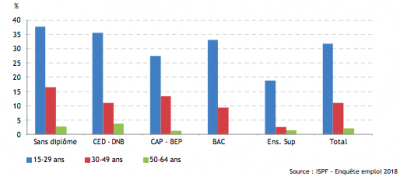Labor force survey:
This survey aims to describe the labour force in a structural and cyclical way.
It is the only source providing a measure of the concepts of activity, unemployment, employment and inactivity as defined by the International Labour Office (ILO).
Some figures for the 2018 Labor Survey in French Polynesia:
3,900 households interviewed i.e. more than 10,000 people surveyed. The representative sample was constructed from the 2017 census:
- 2,300 households in Tahiti and Moorea;
- 580 households in the Leeward Islands (Raiatea, Tahaa, Bora-Bora, Huahine);
- 290 households in the Marquesas and Austral Islands;
- 430 households in Tuamotu-Gambier.
“Lien”
In it publication of the first results from the Labor Survey in the Windward group of French Polynesia, the ISPF concluded that the employment rate among the population of the archipelago of Society Islands (persons aged 15 to 64) was 51.2%, i.e. 85,200 people in employment.
Among employed people, 24% are self-employed (self-employed, entrepreneurs, family carers or informal workers). This rate is twice as high as in metropolitan France, and also higher than in the French overseas departments or New Caledonia (from 13% to 20%).
Quelques chiffres sur l'Enquête Emploi de 2018 en Polynésie française
- 3 900 ménages enquêtés, soit plus de 10 000 personnes interrogées. L’échantillon représentatif a été construit à partir du recensement de 2017 :
- 2 300 ménages sur Tahiti et Moorea ;
- 580 ménages dans les Îles Sous-le-Vent (Raiatea, Tahaa, Bora-Bora, Huahine) ;
- 290 ménages aux Marquises et aux Australes ;
- 430 ménages aux Tuamotu-Gambier.
Quelques résultats
- L’ISPF conclut à un taux d’emploi de 51,2 % parmi la population des îles de La Société en âge de travailler (personnes âgées de 15 à 64 ans), soit 85 200 personnes en emploi.
- Parmi les personnes en emploi, 24 % occupent un emploi non salarié (travailleurs indépendants, chefs d’entreprise, aidant familial ou encore travailleur informel).
- Ce taux est deux fois plus élevé qu’en France métropolitaine, et également plus élevé que dans les départements d’Outre-mer ou en Nouvelle-Calédonie (de 13 % à 20 %).
- 22% des personnes en âge de travailler sans emploi en souhaiteraient un.
Répartition des actifs et des inactifs dans la population des 15-64 ans

Source : ISPF - Enquête emploi 2018
Taux de chômage selon la tranche d'âge et le diplôme le plus élevé

